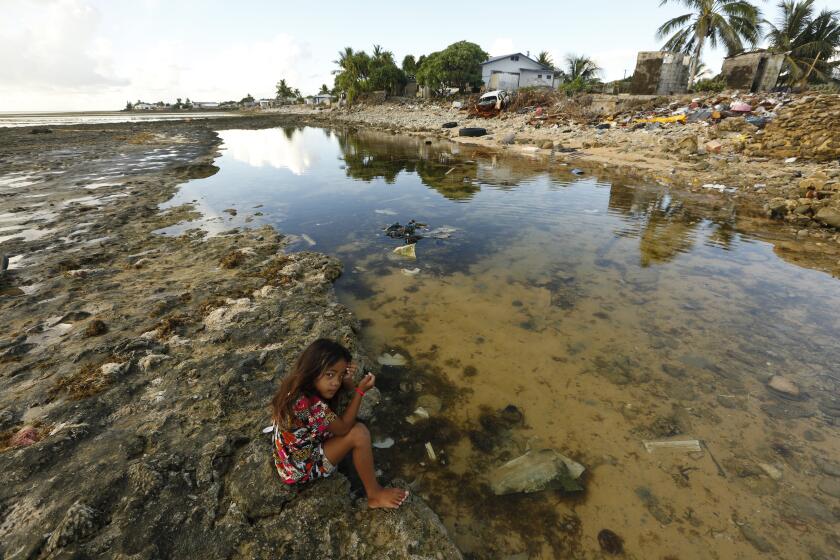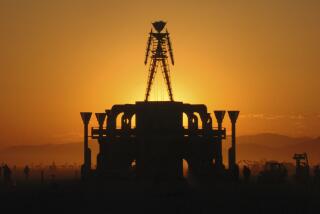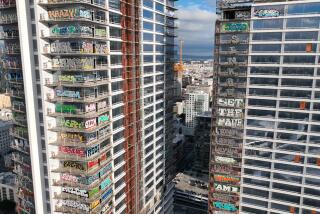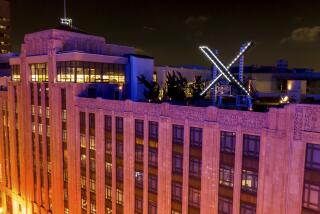U.S. wonât clean up Marshall Islands nuclear waste dome but wants it free of anti-U.S. graffiti
For years, American authorities have asserted they hold no responsibility for Runit Dome, a concrete-capped waste site in the Marshall Islands, where the United States dumped 35 Olympic swimming poolsâ worth of atomic soil and debris created by its Cold War nuclear weapons testing program.
But sometime during the spring of 2018, unknown vandals spray-painted graffiti across its face: âNuclear Waste. Property of USA Government. Please Return to Senderâ and âNuclear Waste. Property of the USA. Please Return to Sender.â
That grabbed the attention of the U.S. government and its contractors.
Despite its position that the dome and its radioactive contents belong to the Marshallese government, the U.S. Department of Energy paid a contractor to scrub off the offending message after getting permission from the mayor of Enewetak Atoll, where the dome is located.
The âgraffiti on the dome was removed by Lawrence Livermore National Laboratory, a US DOE contractor,â the mayor, Jack Ading, said in an email this week to The Times.
Ading said he probably should have rejected the request to remove it â made by Terry Hamilton, a contractor for the Lawrence Livermore National Laboratory â because the message on the dome reflected Marshallese sentiment that the United States should take ownership of its radioactive waste. But he decided to go along to avoid conflict.
âI did not want to fight with USG over a graffiti,â he said, referring to the U.S. government.
In a special report Sunday, The Times documented how Runit Dome is threatened by sea level rise and could eventually spill its radioactive contents into the ocean around Enewetak. While the United States has repeatedly declared it bears no obligation to fortify the structure or take ownership of the waste, the graffiti cleanup reveals it is attentive to keeping the dome free of anti-U.S. slogans.
Some find it ironic that the Energy Department and its contractors are keeping the surface of the dome clean, while doing nothing to prevent the radioactive waste from leaking out of it.
âWhen there are limited resources, it is disheartening that graffiti removal would take priority over other basic services and requests,â said Holly Barker, an anthropologist at the University of Washington in Seattle.
We started out planning to focus on the U.S. legacy of radiation in the Marshall Islands, then encountered firsthand the effects of climate change. Both issues are converging in the central Pacific.
From 1946 to 1958, the United States detonated 67 nuclear bombs in the Marshall Islands. Forty-three of those tests were conducted in Enewetak lagoon. It also conducted biological weapons testing in the atoll and shipped in 130 tons of soil from an atomic testing ground in Nevada for experiments.
During the late 1970s, as the United States was returning control of Enewetak to the Marshallese, the U.S. government initiated a cleanup of the atoll â to remove the most lethal and irradiated land-based soil and debris. It dumped that waste in a 350-foot-wide unlined nuclear bomb crater pit on Runit Island, and then covered it with an 18-inch-thick concrete cap.
The dome, which resembles an old, weathered Houston Astrodome and can be seen from miles away, is reportedly leaking plutonium-laced groundwater into the Enewetak lagoon and Pacific Ocean.
Journalist Mika Makelainen was at the dome on May 25, 2018, soon after the vandalism took place.
âThe graffiti looked fairly new, and none of the Marshallese guys had seen it before,â said Makelainen, who works for the Finnish broadcast news service Yle.
He said it was rumored that âa very large sailing boat had visited Runitâ before his arrival, and it was believed by the Marshallese that people on that boat could have been responsible.
During an interview last fall, at his Livermore laboratory, Hamilton said he learned about the graffiti incident after being informed by Enewetak officials, whom he described as displeased by the vandalism, contrary to Adingâs account. Hamilton said he sent out one of the Energy Department technicians living on Enewetak to clean up the graffiti.
âThey helped wash some of that off,â he said, adding that he thought the graffiti was still visible from a droneâs eye view. âItâs not obvious when you are walking around.â
A Times reporting team did not see the graffiti when it visited in August 2018, and no sign of it is visible in The Timesâ drone video or photographs.
A spokeswoman for Lawrence Livermore did not respond to recent inquiries about the graffiti, or the cost of the cleanup.
The U.S. government has provided the Marshallese with about $30 million a year since 2003. In 2023, a so-called compact of free association signed by the two countries, which governs the relationship between them, is set to expire.
This summer, U.S. Secretary of State Michael R. Pompeo announced that the United States intends to extend the compact. Negotiations are just beginning.
See Mäkeläinenâs article here. And Yleâs virtual reality tour of the Marshalls.








